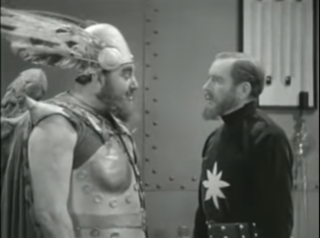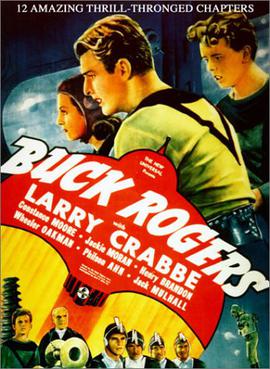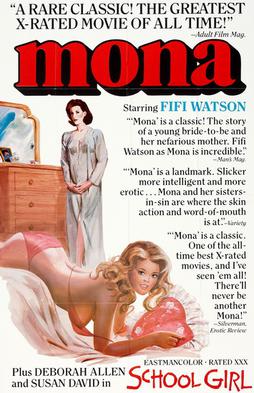
Flash Gordon is the protagonist of a space adventure comic strip created and originally drawn by Alex Raymond. First published January 7, 1934, the strip was inspired by, and created to compete with, the already established Buck Rogers adventure strip.

Flash Gordon is a 1936 superhero serial film. Presented in 13 chapters, it is the first screen adventure for Flash Gordon, the comic-strip character created by Alex Raymond in 1934. It presents the story of Gordon's visit to the planet Mongo and his encounters with the evil Emperor Ming the Merciless. Buster Crabbe, Jean Rogers, Charles Middleton, Priscilla Lawson and Frank Shannon portray the film's central characters. In 1996, Flash Gordon was selected for preservation in the United States National Film Registry by the Library of Congress as being "culturally, historically, or aesthetically significant".

Dale Arden is a fictional character, the fellow adventurer and love interest of Flash Gordon and a prototypic heroine for later female characters, including Princess Leia and Padme Amidala in Star Wars. Flash, Dale and Dr. Hans Zarkov fight together against Ming the Merciless.

Flash Gordon Conquers the Universe is a 1940 American black-and-white science-fiction 12-chapter movie serial from Universal Pictures, produced by Henry MacRae and co-directed by Ford Beebe and Ray Taylor. The serial stars Buster Crabbe, Carol Hughes, Charles B. Middleton, Frank Shannon, and Roland Drew. It was written by George H. Plympton, Basil Dickey, and Barry Shipman, and was adapted from Alex Raymond's syndicated newspaper comic strip of the same name from King Features Syndicate. Shown theatrically in 12 separate weekly "chapters", it was the last of the three Universal Flash Gordon serials made between 1936 and 1940.

Ming the Merciless is a fictional character who first appeared in the Flash Gordon comic strip in 1934. He has since been the main villain of the strip and its related movie serials, television series and film adaptation. Ming is depicted as a ruthless tyrant who rules the planet Mongo.

Prince Vultan is a fictional character in the Flash Gordon comic strip and its adaptations. Vultan is the ruler of the Winged Bird-Men, a race of flying extraterrestrials who dwell in Sky City, a metropolis that floats in the sky. He fits the archetype of the Viking: strong, hearty, and with a great appetite for life, food, drink, and women.

Flash Gordon's Trip to Mars is a 1938 Universal Pictures 15–chapter science-fiction movie serial based on the syndicated newspaper comic strip Flash Gordon. It is the second of the three Flash Gordon serials made by Universal between 1936 and 1940. The main cast from the first serial reprise their roles: Buster Crabbe as Flash Gordon, Jean Rogers as Dale Arden, Frank Shannon as Dr. Alexis Zarkov, Charles B. Middleton as Ming the Merciless, and Richard Alexander as Prince Barin. Also in the principal cast are Beatrice Roberts as Queen Azura, Donald Kerr as Happy Hapgood, Montague Shaw as the Clay King, and Wheeler Oakman as Ming's chief henchman. The serial was followed by Flash Gordon Conquers the Universe (1940).

Flesh Gordon Meets the Cosmic Cheerleaders is a 1990 superhero sex comedy film, and the sequel to the sex comedy Flesh Gordon. Like the original, it spoofs the Flash Gordon serials, though the humor is more scatological than the original. Only William Dennis Hunt returns from the original cast.

Flash Gordon is a 1980 American space opera superhero film directed by Mike Hodges, based on the King Features comic strip of the same name created by Alex Raymond. The film stars Sam J. Jones, Melody Anderson, Ornella Muti, Max von Sydow and Topol, with Timothy Dalton, Mariangela Melato, Brian Blessed and Peter Wyngarde in supporting roles. The film follows star quarterback Flash Gordon (Jones) and his allies Dale Arden (Anderson) and Hans Zarkov (Topol) as they unite the warring factions of the planet Mongo against the oppression of Ming the Merciless, who is intent on destroying Earth.

Flash Gordon is a 1996 animated television series based on the sci-fi comic strip of the same name. The character, who had been around in the comics pages since Alex Raymond created him in 1934, had recently starred in several film serials, a 1980 feature film, and two earlier cartoon series — The New Adventures of Flash Gordon and Defenders of the Earth.

The New Adventures of Flash Gordon, also known as The Adventures of Flash Gordon, is a 1979–1982 animated television series. The series is actually called Flash Gordon but the expanded title is used in official records to distinguish it from previous versions. Filmation produced the series in 1979, partly as a reaction to the mammoth success of Star Wars in 1977. The series was an homage to the original Flash Gordon comic strip and featured many of the original characters, including Flash's girlfriend Dale Arden, and the scientist Hans Zarkov. The series is still regarded as one of the most faithful adaptations, and one of Filmation's finest overall efforts.
Prince Thun is a fictional character who appeared in various forms of the Flash Gordon comic strip and film productions. He is a Lion Man of Mongo and one of Flash's most trusted friends. His Father is King Jugrid, ruler of the Lion Men, and one of the three mightiest rulers of Mongo.

Buck Rogers is a 1939 science fiction film serial, produced by Universal Pictures. It stars Buster Crabbe as the eponymous hero, Constance Moore, Jackie Moran and Anthony Warde. It is based on the Buck Rogers character created by Philip Francis Nowlan, who had appeared in magazines and comic strips since 1928.

Mona is a 1970 American pornographic film directed by Michael Benveniste and Howard Ziehm, produced by Bill Osco, and starring Judy Angel, Gerard Broulard, Orrin North, Susan Stewart and Fifi Watson. The film was screened without credits due to legal concerns. It is regarded as the second sexually explicit film to receive a general theatrical release in the United States, after Andy Warhol's Blue Movie (1969). However, unlike Blue Movie, Mona had a plot, though there was more emphasis on the action.

Flash Gordon: The Greatest Adventure of All is a 1982 animated television film produced by Filmation and written by Samuel A. Peeples. It was broadcast on NBC on August 21, 1982.

Purple Death from Outer Space is a 1966 American black-and-white science fiction film directed by Ford Beebe and Ray Taylor. It is the first of two feature-length compilations of the 1940 serial Flash Gordon Conquers the Universe. The second, Perils from the Planet Mongo, was released the same year.
Bill Osco is an American film producer and director.

Flash Gordon Classic is a 2015 animated fan film made by Robb Pratt. It is a remake of "The Tunnel of Terror", the second episode of the 1936 Flash Gordon serial.
Howard Ziehm is a retired American director, director of photography, producer and writer of adult movies.

A serial film,film serial, movie serial, or chapter play, is a motion picture form popular during the first half of the 20th century, consisting of a series of short subjects exhibited in consecutive order at one theater, generally advancing weekly, until the series is completed. Usually, each serial involves a single set of characters, protagonistic and antagonistic, involved in a single story, which has been edited into chapters after the fashion of serial fiction and the episodes cannot be shown out of order or as a single or a random collection of short subjects.
















